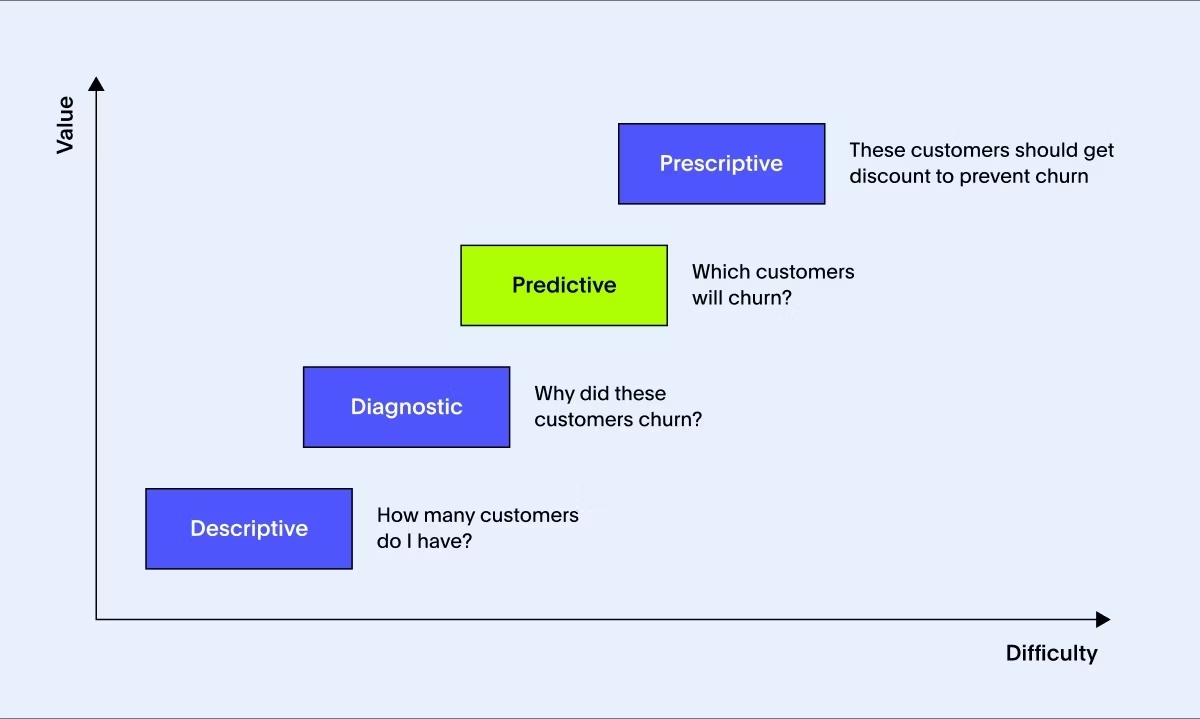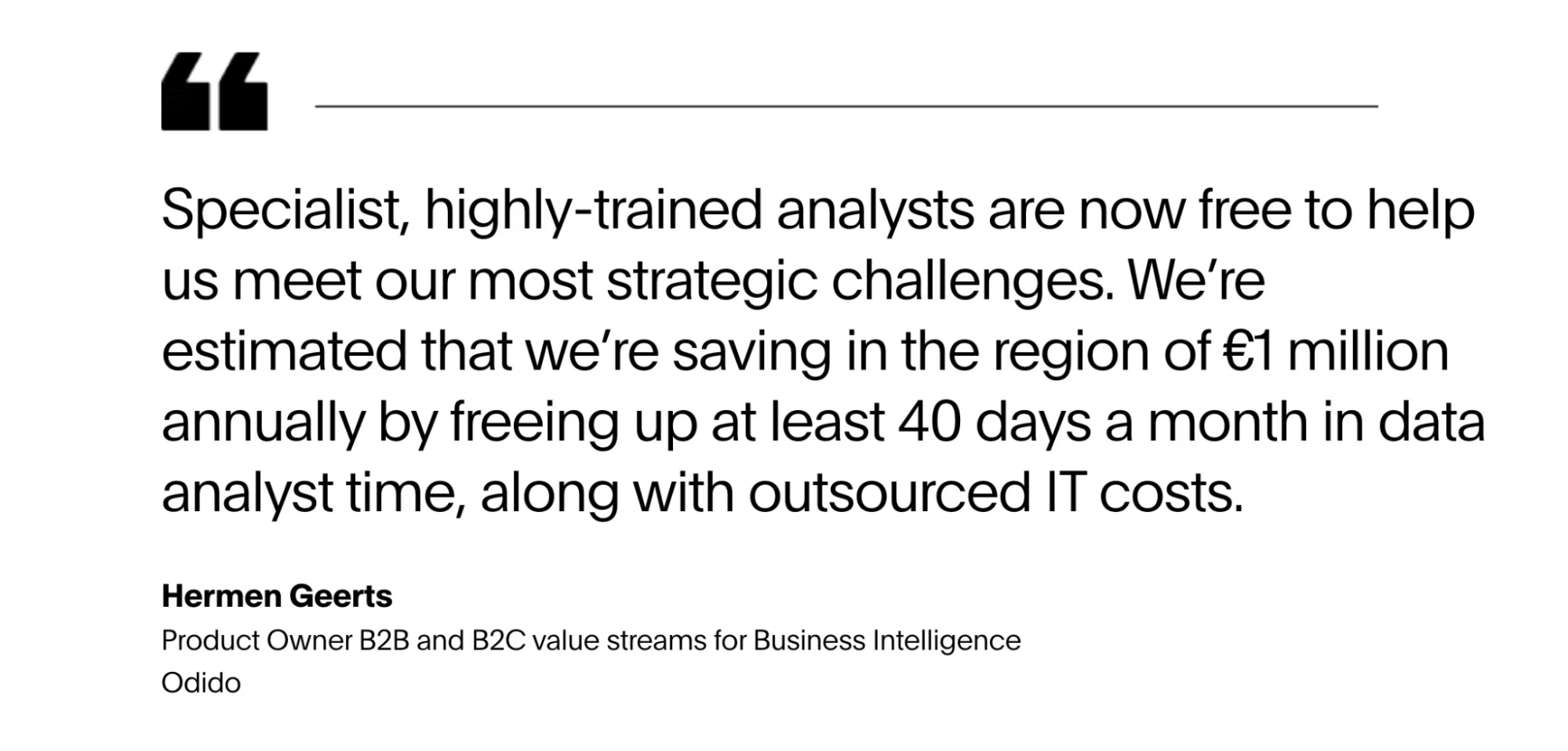Predictive analytics is an advanced data analytics technique that uses data to predict future outcomes. With artificial intelligence, machine learning, data mining, and statistical modeling, predictive analytics provides the answer to your ‘What will happen next?’ question. This type of analysis helps companies take proactive actions and stay ahead of their competition.
Decision-makers today are grappling with a lot of questions: What’s our projected sales revenue for the next quarter? Which projects are at a higher risk of delays? Will we be cash-flow positive in the upcoming months? What programs should we cut to hit our margin targets?
Predictive analytics can provide the answer to all these questions.
As we enter the age of Data Renaissance, GenAI and machine learning are not only changing the way companies interact with data but also expanding their capability to better anticipate outcomes.
Table of contents:
Organizations are looking for ways to use data to boost customer experiences, enhance their product offerings, and reduce costs. While data analytics generally plays a large role in converting raw data into actionable insights, using the right type of analytics can help you fully capitalize on your data assets.
Consider this example: Imagine you are running an e-commerce business and want to optimize your marketing campaigns. To do this, you will leverage the different types of analytics to understand data and make data-driven decisions:

Descriptive analytics will help you understand: ‘'What were the key metrics of past campaigns?’
Diagnostic analytics will help you understand: “Why did certain campaigns perform better than others? Were there specific factors?”
Predictive data analytics will help you understand: “What trends can we anticipate in customer behavior?”
Prescriptive analytics will help you understand: “What specific steps can be made to enhance the campaign’s effectiveness?'
Each of the above types of data analytics helps you gain a holistic picture of your business, empowering you to turn insights into action.
To build a predictive analytics model, you should first understand whether it falls under the supervised or unsupervised machine learning method. This distinction will better help you predict the output from new input data.
Supervised machine learning vs unsupervised machine learning
The supervised machine learning method generally helps you classify data and predict business outcomes. The machine is trained on a labeled dataset and the goal is to make predictions or classify new, unseen data accurately.
On the other hand, unsupervised machine learning methods are trained on unlabeled data, helping you understand the trends and patterns in the dataset. Now, let’s understand some of the most popular predictive analytics models:
1. Classification models
This is a supervised machine learning method that puts data objects into categories based on historical knowledge. The primary goal of a classification model is to learn from historical data—where the classes are already known—and then make predictions for new, unseen data. Some popular classification model techniques are random forests, decision trees, and neural networks.
This predictive analytics technique is widely used in retail businesses to anticipate customer churn. Other industries, such as banking and insurance, use classification models focusing on fraud detection.
2. Regression models
Regression models also fall under the branch of supervised machine learning. These models have different techniques, such as correlation, outlier detection, and distribution evaluation which predict continuous data by establishing relationships between a dependent variable and one or more independent variables.
These models help analyze how changes in one factor can influence another factor’s outcome. Companies mostly use this technique for sales forecasting, financial projections, churn prediction, and workforce planning.
3. Clustering models
Clustering models are part of unsupervised machine learning. Their primary purpose is to group data points based on similar attributes. These models help reveal hidden patterns within data and organize it into meaningful groups.
A common use case for clustering is customer segmentation. Using methods like K-Means or hierarchical clustering, you can create these segments without identifying key variables prior to analysis. These segments then help marketers personalize campaigns so that they cater more directly to the target audience, in effect aiding in customer retention and revenue generation.
4. Time series model
The time series model uses a mixture of supervised and unsupervised techniques that predict patterns in data points over time. Essentially, this model takes in data from previous periods, such as monthly or quarterly sales, and then uses it to estimate future outcomes.
For example, a retailer may use a time series model to analyze historical sales data, identify seasonality patterns, and predict future demand estimates. These insights help them strategically plan inventory, optimize operational efficiency, and reduce lead times.
Data scientists develop predictive models or use predictive analytics tools to analyze historical data and predict future events. Here’s a brief overview of the process works:
Identify the problem: Clearly articulate the business problem or goal you want to address with predictive data analytics. For instance, you may want to know which products will experience increased demand in the next quarter. Writing down a distinct problem statement will help you gather relevant data and scope out the details.
Collect and organize the data: Gather data relevant to the outcome you are trying to predict. This can include customer information, transaction data, data from CRM systems, and more. After gathering relevant data, you can organize everything in a data warehouse to create a single source of truth.
Prepare the data: Use data observability tools to identify and remove discrepancies, such as missing values, duplicate data, or outliers. This process is known as data cleaning and is essential for maintaining the accuracy of the results.
Choose the right predictive model: Select an appropriate predictive model depending on the identified and the nature of the dataset. Some of the most common models include linear regression, decision trees, cluster models, and time series models outlined above.
Develop and deploy the model: Leverage machine learning, AI, and advanced statistical techniques to develop and train the model. Integrate the model into business processes, software applications, or decision support systems.
Validate and test results: Teach your model how to provide accurate, business-specific answers. The human-in-the-loop element ensures relevancy. Test your machine learning model on a test dataset to assess how accurately the model analyzes new, unseen data. This phase utilizes evaluation metrics like confusion matrix, log loss, and more to assess the model's performance in a real-world scenario. precision, and oversight.
Optimization: Based on the results, parameters should be fine-tuned to improve performance.
Need help improving collaboration between business and data teams to identify and prioritize business problems? Read our ‘Context is Gold’ whitepaper.
Predictive data analytics acts as a gateway into the future, offering you a wealth of insights to guide informed decision-making. By embracing future opportunities and mitigating potential risks, organizations are better equipped to streamline operations, boost revenue, and stay ahead of the competition. But this is not all. Let’s explore how predictive analytics is helping industry leaders drive business outcomes:
Optimizing resource allocation: Sales forecasting and annual financial predictions can help operational leaders take proactive actions to optimize existing business processes and make better adjustments to their procurement and production methods. For instance, demand forecasts can help you better plan inventories to prevent stockouts and manage the workforce. These insights are proven to help you reduce operational costs and minimize the risk.
Create go-to-market strategies: Predictive data analytics helps marketing and sales pros unearth new trends and anticipate customer behavior. With these insights, you can tailor relevant content, create targeted ads, and even send personalized product recommendations to increase engagement.
Improving decision-making: Running a successful business involves considering different choices, weighing pros and cons, and then making a concrete decision. With predictive analytics, you can anticipate future trends to make forward-looking decisions.
1. Healthcare
Healthcare analytics have been a driving force in enhancing patient outcomes and reducing costs. For instance, using predictive models and machine learning, healthcare providers can predict and detect diseases in their patients before they become serious. This early detection allows for timely interventions and personalized care plans, enhancing the quality of patient care and ultimately contributing to more effective management.
Here’s a real-life predictive analytics example of how two healthcare powerhouses—Gilead Sciences and ZS Associates use predictive analytics to improve patient outcomes:
“The ecosystem has been quite sophisticated, we apply AI use cases to predict the likelihood of a prescriber writing a script before a script is being written. You can prescribe and actually predict a patient dropping a therapy before it drops, or you can actually predict a plan changing their formulary status before it happens.”
2. Finance
For any business to be successful, having a positive cash flow and a strong portfolio is absolutely essential. Financial institutions leverage predictive analytics to create cash flow dashboards and calculate future returns on their portfolio to make data-driven decisions on allocating resources and managing risk.
3. Cybersecurity
Protecting your data from sophisticated cyberattacks requires adopting a proactive approach to protect your information online. To do this, you require a robust system that identifies fraudulent patterns, detects anomalies, and predicts potential vulnerabilities. Predictive analytics also helps in running scenario testing and assessing security risks so you can immediately trigger specific security procedures and limit exposure to an attack.
4. Human resources
Predictive analytics helps HR teams identify skills gaps within the organization. By analyzing existing data, HR leaders can use the model to predict future training needs of employees. These insights can help them create personalized learning pathways to bridge the gap and ensure the workforce remains aligned with organizational goals.
As a business leader, your job of finding answers to complex problems never stops. Leveraging data and utilizing advanced analytics techniques can help you unlock actionable insights, capitalize on growth opportunities, and plan for the future.
With ThoughtSpot’s AI-Powered Analytics solution, you can easily access real-time data, get AI-assisted insights, and drill into data using natural language, enabling your team to find and visualize insights—making predictive analytics accessible to everyone in the organization.
This was the case for Odido, who saved over €1 million in data costs by putting data at the center of decision-making with ThoughtSpot. Here’s what Hermen Geerts, Product Owner at Odido, has to say about ThoughtSpot and its ability to democratize data:

Experience how easy it is to unlock the insights in your data using ThoughtSpot—sign up for a free demo today!








